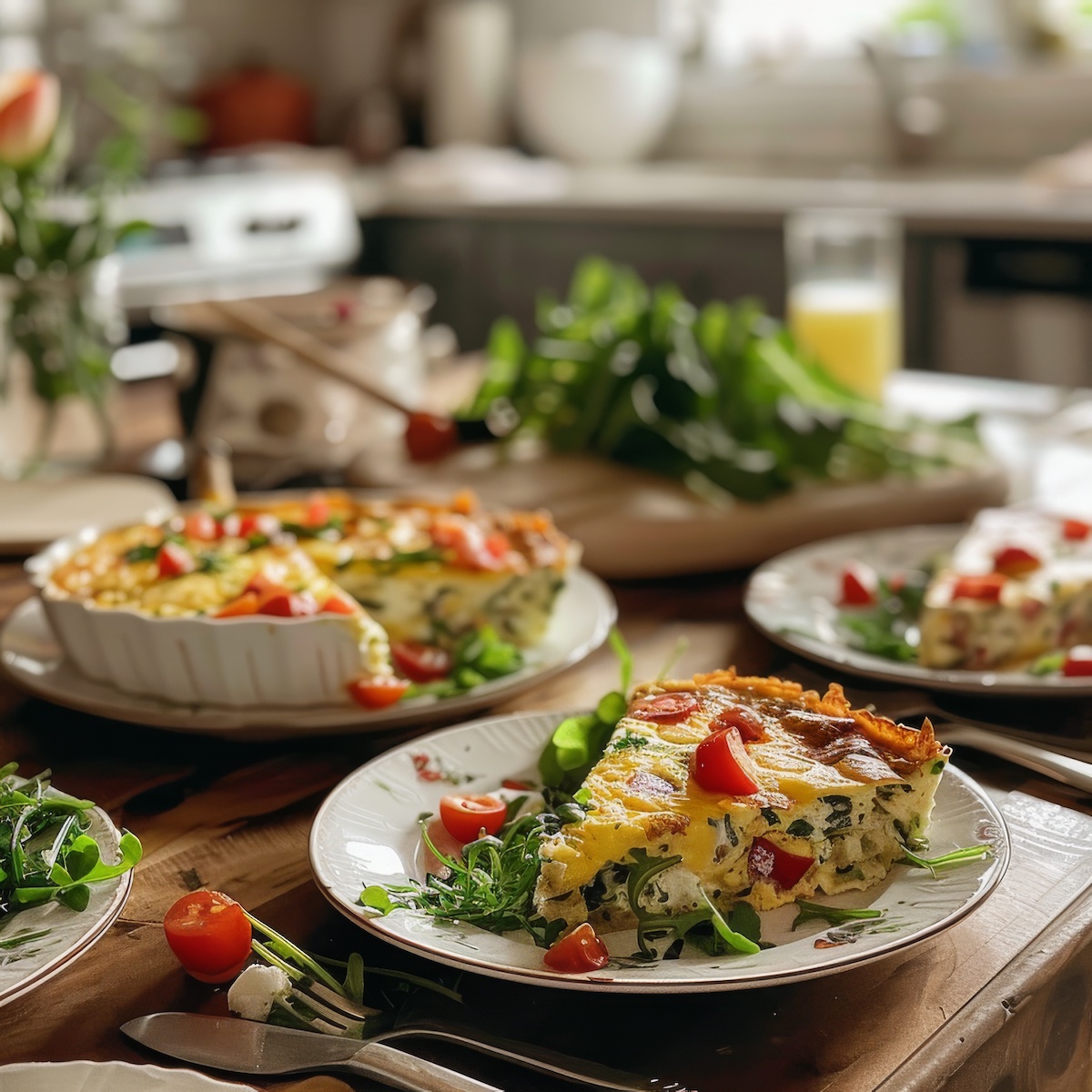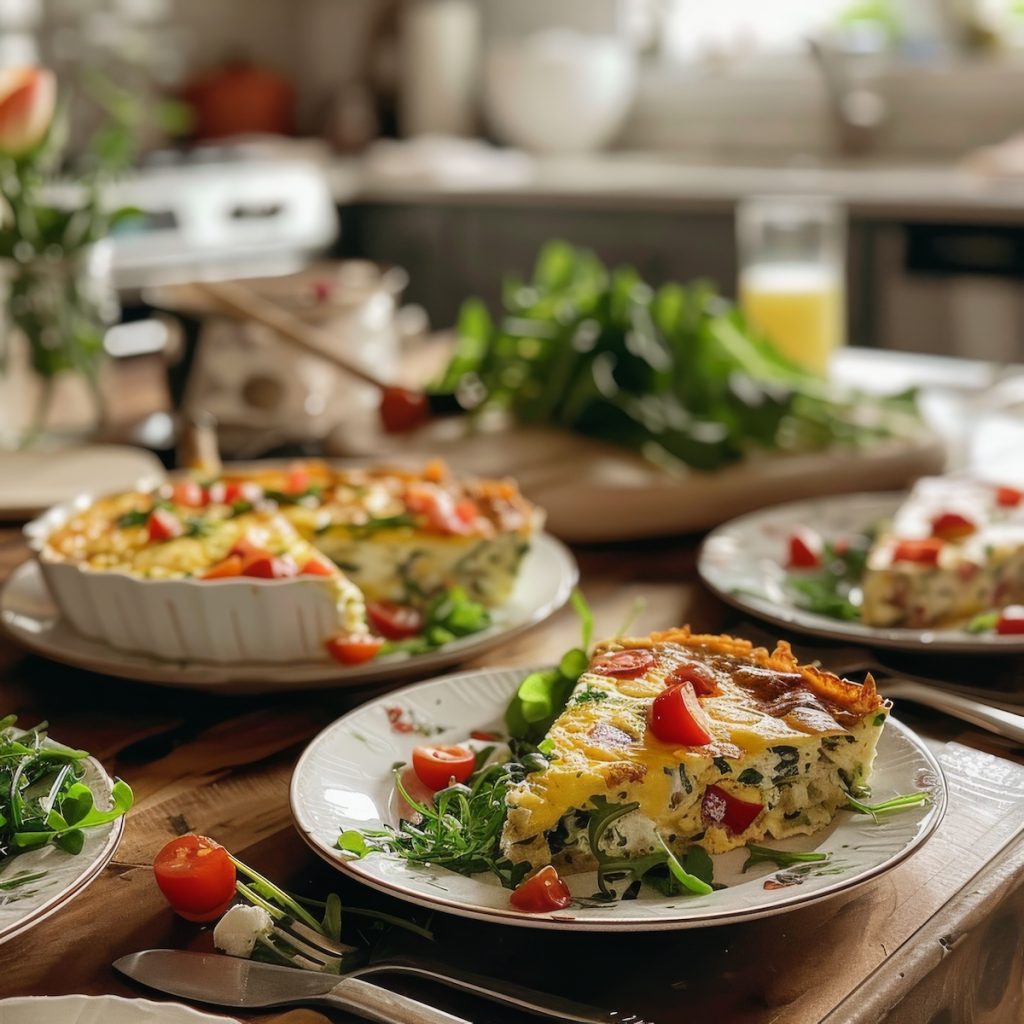
Is it an Omelet, Frittata or Quiche?
Omelets, frittatas, and quiche are beloved egg-based dishes with unique textures and flavor profiles. Whether you’re looking for a quick breakfast, a hearty brunch, or even a simple weeknight dinner, these versatile dishes can be customized with various ingredients to suit any palate.
Omelets are a quick stovetop classic known for their light and fluffy texture. Typically folded around fillings like cheese, vegetables, or meats, they’re a go-to for anyone seeking a fast, savory meal.
On the other hand, Frittatas are more substantial and often considered a crustless quiche, cooked both on the stovetop and in the oven. This method produces a thicker, hearty egg dish perfect for sharing, fostering a sense of connection and community.
Quiche stands out with its buttery, flaky crust, adding a rich dimension to the baked egg filling. Popular for brunch or special gatherings, quiche can be served warm or at room temperature, making it a versatile choice.
Each dish showcases eggs in its best light, and mastering them will open the door to endless culinary creativity as you mix and match fillings and flavors to craft your perfect meal.
Here they are, a trinity of brunch egg dishes – omelet frittata quick. All three of these preparations are lovely for some of the same reasons:
- they help you use up leftovers,
- they impress your friends
- potatoes are a welcome but somewhat unusual addition.
While all three of these dishes contain eggs, the preparation methods vary. So, to clear up any confusion, here is a primer on omelets, frittatas, and quiche.
Omelets
Omelets are a classic and versatile egg dish enjoyed in various cultures worldwide. They are made by beating eggs and cooking them in a skillet, typically with various fillings ranging from simple to elaborate. Known for their quick preparation and customizable nature, omelets are famous for breakfast, brunch, and dinner.
The basic process of making an omelet starts with beating eggs until they are well combined. The eggs are poured into a heated, buttered, or oiled skillet. As the eggs cook, they are often gently stirred or tilted to ensure even cooking. The fillings are added once the eggs are mostly set but still slightly runny on top. Typical fillings include cheese, bell peppers, onions, mushrooms, spinach, tomatoes, meats such as ham, bacon, and sausage, and herbs like chives, parsley, and basil.
One of the most well-known types of omelets is the French omelet, characterized by its smooth, silky texture and folded shape. It is typically cooked over low heat and stirred constantly to create small curds. The finished product is often pale yellow with a soft, custardy interior. In contrast, the American-style omelet is cooked over medium heat, allowing the eggs to form larger curds, often resulting in a more browned exterior. It is usually folded in half around the fillings.
Omelets are celebrated for their adaptability. They can suit any taste or dietary preference, whether a vegetarian version with an array of fresh vegetables or a hearty meat and cheese combination. Also, omelets can be a great way to use leftover ingredients, making them an economical and practical choice for many home cooks.
In addition to being a quick and easy meal, omelets are nutritious, providing a good source of protein, vitamins, and minerals. They can be paired with side dishes such as toast, salads, or hash browns to create a balanced meal.
Omelets are a delightful and versatile dish that offers endless possibilities for creativity in the kitchen. Their simple preparation and rich flavors make them a beloved cuisine staple worldwide.
Frittatas
Frittatas are a versatile and delicious Italian egg-based dish that resembles an omelet or crustless quiche. They are known for their rich flavor, ease of preparation, and flexibility in incorporating various ingredients. Typically served as a main course for breakfast, brunch, or light dinners, frittatas are also famous as appetizers or snacks.
To make a frittata, eggs are beaten and mixed with a variety of fillings, such as vegetables, meats, cheeses, and herbs. Common ingredients include bell peppers, onions, spinach, mushrooms, potatoes, tomatoes, ham, bacon, sausage, mozzarella, feta, and Parmesan cheeses. The mixture is seasoned with salt, pepper, and herbs like basil, parsley, or thyme.
Cooking a frittata typically involves two steps. First, the egg mixture is partially cooked on the stovetop in an oven-safe skillet, usually over medium heat. This step ensures that the eggs start to set and the fillings meld together. Once the edges are set but the center remains slightly runny, the skillet is transferred to the oven to finish cooking under the broiler. This method ensures the frittata is evenly cooked and develops a beautifully browned top.
Frittatas are celebrated for their simplicity and the ability to use up leftovers or seasonal ingredients. They are a practical choice for home cooks looking to create a nutritious and satisfying meal with minimal effort. The dish is also highly adaptable, allowing for endless variations to suit different tastes and dietary preferences.
In addition to their versatility, frittatas can be enjoyed hot or at room temperature, making them an excellent option for make-ahead meals or picnics. They pair well with various side dishes, such as fresh salads, roasted vegetables, or crusty bread, making for a well-rounded meal.
Frittatas are a delightful and flexible dish that embodies the principles of simple, flavorful, and resourceful cooking. Whether enjoyed as a quick breakfast, a leisurely brunch, or a light dinner, frittatas offer a satisfying and nutritious option that can be tailored to any palate.
Quiche
Quiche is a savory tart originating from France, renowned for its creamy custard filling, typically composed of eggs, milk or cream, and various other ingredients baked in a pastry crust. The dish is versatile and can be enjoyed at any meal, making it a popular choice for breakfast, brunch, lunch, or dinner.
The most famous quiche is the Quiche Lorraine, named after the Lorraine region in northeastern France. Traditional Quiche Lorraine is made with a rich custard base mixed with lardons, bacon, and sometimes Gruyère cheese. Over time, variations have emerged, incorporating ingredients such as spinach, mushrooms, leeks, ham, and various cheeses.
To prepare a quiche, the pastry crust is usually pre-baked (a process known as blind baking) to ensure it stays crisp when the filling is added. The filling is a mixture of beaten eggs and milk or cream, which creates a custard-like consistency when baked. The desired ingredients, whether vegetables, meats, or cheeses, are mixed into the custard. Seasonings such as salt, pepper, and nutmeg are often added to enhance the flavor.
One of the critical attributes of quiche is its adaptability. It can be served hot or cold, making it suitable for picnics, parties, or quick meals. It pairs well with a fresh salad for a balanced and satisfying meal. Additionally, quiche can be made and refrigerated or frozen for later use, adding convenience.
Quiche’s popularity extends beyond France; it has become a beloved dish in many parts of the world. Its elegant yet simple preparation makes it a staple in home kitchens and fine dining establishments. The endless possibilities for fillings allow for creativity and customization, catering to diverse tastes and dietary preferences.
Quiche is celebrated for its rich, creamy texture and endless variations. Whether sticking to classic recipes like Quiche Lorraine or experimenting with new ingredients, quiche remains a timeless and versatile dish that continues to delight palates worldwide.








4 Responses
Ah, I see you subscribe to the Julia Child school of French omelets. But wait…there’s more: the French have a large variety of omelets dating back to the 14th-century. I’d suggest reading my article Les Omelettes from 2005.
hi i would like to ask u how to make
quiche
thanx in advance
Hi Peter,
Thanks for bringing your article “Les Omelettes” to my attention. Great information. Here is an excerpt from Peter’s article and a link to read the entire piece.
“Omelets have been a part of French cuisine for hundreds of years. One of the earliest texts about French cooking is a single large chapter in the manuscript called Le Ménagier de Paris. Written around 1393, Le Ménagier has two recipes for alumelles, thought to be an early reference to flat omelets. In 1653, François Pierre de la Varenne published his Le Patissier François with 22 recipes for sweet and savory aumelettes, many of which are almost identical to recipes published three centuries later.
The place of the omelet today in a French meal is not as a breakfast dish, but as an entrée (a first course) or a dessert. Add a little extra milk and sugar to a basic omelet preparation and you have a custard. Add a little flour and the omelet becomes a crepe batter. (The omelets we are concerned with in this article are those made primarily with eggs.)
Early omelets were served flat or rolled. Nowadays, they can be flat, rolled, folded, stacked, or souffléed. They can be savory or sweet. The filling can be mixed with the eggs or rolled inside the cooked eggs or spread across the top of the finished dish.
In former times, it was recommended that the frying pan used for omelets be only used for that purpose. Today, with the availability of nonstick surfaces, this is less important. More important is that the shape of the pan allows for easy removal of the finished omelet, usually by sliding it out of the pan.”
For the entire article, go to http://www.hertzmann.com/articles/2005/omelettes/
thank you… great info and history… LOVE food history. reading your article i came up with salmon & herb quiche in a potato crust…YUM!! Thanks!